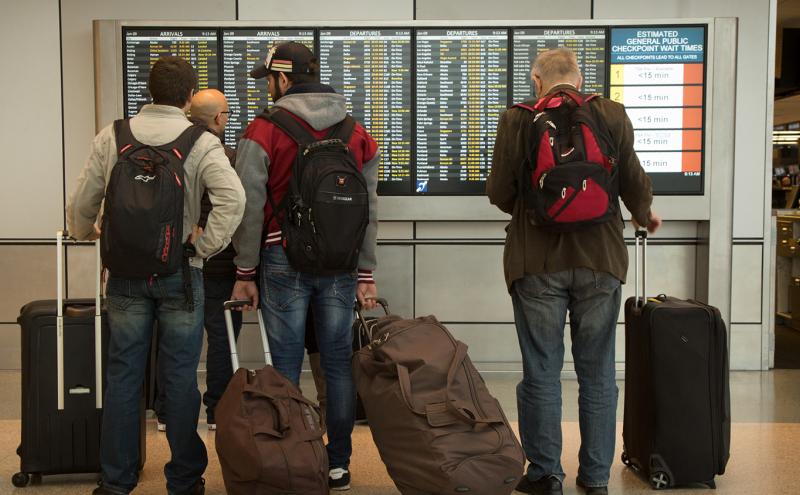Enhancing traveler awareness, port accountability, and customer service standards for departing international passengers.
SEATTLE – The Port of Seattle continued its efforts to lead the development of biometric policies and procedures that emphasize travelers’ privacy and civil liberties, while ensuring a safe, respectful, and efficient customer experience for those passengers departing Seattle-Tacoma International Airport (SEA) on international flights.
Following months of engagement with the aviation industry, federal officials, and civil liberties groups, the Commission today directed staff to implement new policies governing the implementation of “Biometric Air Exit” at SEA.
Biometric air exit is a federally regulated program that uses facial recognition to confirm the identities of departing international passengers at the boarding gate. All departing international passengers, U.S. citizen or foreign national, have the right to opt out of biometric processing and request manual screening to confirm their identity. Because of its voluntary and one-to-one nature, biometric air exit complies with the Port’s prohibition against mass surveillance using facial recognition technology.
To ensure that Port can enforce policies related to data privacy and traveler rights, the Commission also authorized a Request for Proposals for up to 30 biometric air exit systems for installation at SEA, so that the Port – not the federal government – can control the traveler engagement aspects of this process. The contract award for that RFP will require full compliance with the Port’s biometric air exit policies, such as ensuring that data is not stored or used for commercial purposes and that cameras are appropriately positioned to avoid photographing other passengers.
“Congress mandated that U.S. Customs and Border Protection (CBP) implement a biometric air exit system, we have limited choices on this matter but by taking ownership of the system, we can ensure that it adheres to our principles and that people – especially people of color – are protected,” explained Port Commissioner Sam Cho. “The Commission believes that Port implementation of these procedures is the responsible approach to ensure transparency, accountability, and the best experience for our international passengers.”
How Biometric Air Exit Works
The biometric exit program works by comparing images of departing international passengers taken at the boarding gate with a facial recognition “template” held by CBP based on previously collected images such as passport or visa application photos. The system attempts to match the image to a gallery of biometric templates for that particular flight and transmits a “match/no match” confirmation back.
The biometric air exit program is only used at departure gates and only when international departing flights are boarding. If SEA did not choose to operate biometric air exit itself, CBP has authority to implement the program using its own staff and equipment at any international air departure gate. CBP is already doing this at SEA on certain departing Lufthansa, Hainan, Emirates and Virgin Atlantic flights, and the Commission’s goal is to replace CBP and ensure that the program is run in full accordance with Port policies and standards.
Port Policies
The Port’s biometric air exit policies build on CBP’s existing federal regulations to ensure that all travelers understand the technology, how it is being used and their rights to opt-out if desired; any traveler can choose not to participate in this voluntary process. The Port policies will also establish standards for how airline staff must treat customers participating in this process, standards for avoiding unintended image capture, and ways to treat mismatches with discretion and cultural sensitivity. The full list of policies is available at .
Over two dozen major U.S. airports have implemented this program at their facilities, but none have paired the operation of the system with comprehensive policies and guidelines that enhance the traveler experience and passenger education.
Since the adoption by the Port Commission on December 10 of a motion instituting seven principles to ensure that implementation of public-facing facial recognition technology is clearly justified, equitable, and transparent, port staff have been working collaboratively to translate those principles into policies that can be clearly enforced and measured. Ultimately, there will be five sets of policies proposed by staff – one for each “use case” of potential biometric technology uses at Port facilities:
- Biometric Air Exit
- Biometric Air and Cruise Entry
- Non-Federal Biometric Passenger Processing
- Biometrics for Customer Functions
- Biometrics for Law Enforcement and Security Functions
Staff will return to brief Commissioners in the coming months on the remaining policy recommendations, with Commission action expected by June 30 on an overarching policy implementing these recommendations.
Theodore is the Co-Founder and Managing Editor of TravelDailyNews Media Network; his responsibilities include business development and planning for TravelDailyNews long-term opportunities.










































































































































































